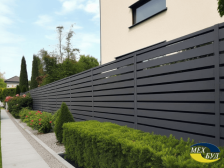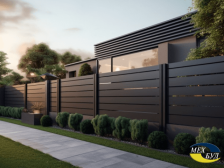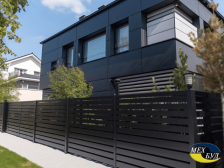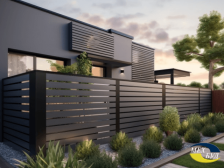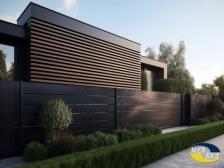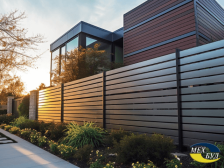Fence in the house design stage
Most people install a fence after the main building is already constructed. However, when it comes to secondary reconstruction, this may be the only option. But when building a new structure, it’s more advisable to design the fencing structure during the house design stage. This allows for optimal resource allocation, ensuring the best results while avoiding several risks.
The issue of designing fences and coordinating their plans with building and other construction projects will be discussed in this overview.

FENCE DESIGN STAGES
Without a design – even for the simplest fence – temporary fences or lightweight enclosure structures can be installed within the plot. However, if the goal is to install a permanent structure that will protect and serve for a minimum of 10-15 years before maintenance is required, a project becomes a necessity.
During the design stage:
- The fence’s installation location is specified to align with the boundary plan and comply with other documentation requirements.
- Soil conditions at the construction site are studied to determine the optimal foundation scheme and prevent settling of the supporting framework.
- The placement of gates/doors is determined.
- The fundamental structure scheme is coordinated, geometric parameters of the fence are selected, primarily its height.
- Materials for the fence are chosen, and fastening elements are developed.

Based on these actions, project documentation is formed, including at a minimum, a fence plan and drawings with a detailed description of the main components: the foundation and section attachment.
FUNCTIONALITY AND VISUAL HARMONY
Why is it so important to design the fence simultaneously with the house design, and ideally, incorporate these stages into a single complex of design work? There are several arguments in favor of this approach:

- Firstly, in both cases, soil research and geodetic surveys are necessary. Therefore, by conducting design work simultaneously, we save time and costs while obtaining the most objective picture.
- Secondly, when designing simultaneously, there is a higher likelihood of identifying and addressing potential issues related to the terrain features, soil conditions, and the routing of utilities (main water pipelines, gas pipelines, power lines, etc.) at an early stage.
- Thirdly, by simultaneously designing both the building (including its location on the plot) and the fence, we can take into account legislative restrictions regarding minimum distances from the fence to the building and other objects. This helps avoid objections from the fire department and other regulatory authorities.
- Additionally, this approach allows us to select the optimal fence design, including choosing the height and deciding on which sections to install – solid, ventilated, or louvered. This can be done later, but it is much more convenient to know in advance what the fence will be like. Perhaps adjustments will need to be made to the building design, such as raising or lowering window levels or changing the orientation of the facade.

- The last argument pertains to the visual component. Simultaneous work on the design of the house and the fence, or more precisely, their design during a continuous process, allows for a more organic visual composition. This applies to both the color palette of the objects and the overall landscape design. Even during the preliminary visualization stage, it is desirable to understand how all the objects on the plot will look so that they can be properly distributed within the available area.
However, when it comes to more practical aspects, experience shows that when ordering the design of the entire plot as a turnkey project (i.e., the house + outbuildings + small architectural forms + landscaping + fence), the cost of the service will be lower than ordering all these works separately. Moreover, having a single contractor execute the project allows for avoiding potential inconsistencies. However, it’s important to discuss the risks separately…
MAIN RISKS IN FENCE DESIGN
The advantages of parallel fence and house design logically imply potential risks. If you first design and build the house and then start thinking about the fence, you may encounter several unpleasant consequences:

- The first obvious nuance is the absence of a fence during the construction phase. Yes, you can install a temporary fence, but in any case, its location and configuration should be determined in advance.
- The next important point is regulations. After the house is built, it may turn out that the fence, which closely abuts the walls, violates sanitary or fire safety norms. This is something that should have been considered when choosing the location for the house because in such a situation, the options for decision-making are limited: no one will want to demolish the house, and moving the fence towards the street or neighbors might not be feasible. Therefore, the risk of fines from regulatory authorities could be close to 100%
- Furthermore, utilities pose a challenge. Underground installation of pipes and cables into the house can obstruct the laying of the foundation for a permanent fence. The foundation will still be laid, but the labor intensity of the work will increase, and there will be a risk of damaging pipelines or cables when excavating the soil. This is why it’s important to know in advance the depth and configuration of the fence foundation and, if necessary, plan for passages for utilities.
- Lastly, by not aligning the two projects, you can encounter a series of minor inconveniences related to the fence’s configuration. For example, after installation, it may become evident that the fence’s height is insufficient to block the view of a window in the bathroom, making it visible from the street. Conversely, a fence that is too tall could obstruct a desirable view, which might have been a reason for purchasing the property in the first place.
All these risks can be mitigated individually, but they will inevitably increase the complexity and cost of the project. Therefore, it’s better to avoid them by designing the fence concurrently with the building itself.
OPTIMAL PROJECT PLANNING AND CONSTRUCTION SCHEME
There is no one-size-fits-all recipe for the “correct” approach—it depends on the complexity of the design and the scale of construction. However, in general terms, it is advisable to follow such a scheme:
- Defining property boundaries.
- Selecting the house design and its placement on the property.
- Analyzing the soil conditions at the foundation locations for both the house and the fence.
- Designing the house concurrently with the fence (height, structure, material, color palette).
- Land and foundation work (communication lines are laid during this stage).
- Installation of temporary fencing.
- Constructing the building to the pre-finishing stage.
- Installing the fence (frame, sections, additional elements).
Following this, on the fenced and secure territory, you can proceed with the finishing work on the building and minor landscaping tasks such as planting greenery, installing statutory lighting fixtures, and more.
INTEGRATING THE FENCE WITH LANDSCAPE DESIGN
Integrating the fence with landscape design is an important aspect that helps create a harmonious and cohesive impression of your property. Here are a few tips on how to achieve this:
- Fence Material Selection: The fence material should align with the overall style of your property and house. For instance, if you have a wooden country-style house, a wooden fence will harmonize well. If you have a modern house with minimal design, a steel or glass fence might be a good choice.
- Utilizing Plants: “Living” fences made of plants can be a wonderful addition to your landscape design. You can use climbing plants to add greenery to the fence, or plant tall shrubs or trees next to the fence to enhance privacy.
- Fence Color: The color of the fence also plays a significant role. You can choose a color that complements the flowers of your house and the plants on your property. For instance, if you have lots of greenery and flowers, a neutral-colored fence can be a good choice.
- Decorative Elements: Adding decorative elements to the fence can help integrate it into the overall design of the property. These can include decorative grates, flower pots, lanterns, or other elements that match the style of your property.
- Consider Terrain: If your property has uneven terrain, you can design the fence to follow the contours of the land. This not only helps integrate the fence into the landscape but can also create interesting visual effects.
Remember that a fence is not just a barrier but also an important design element that can enhance the appearance of your property and make it more attractive.
FENCING FROM MEHBUD FACTORY
Fences from Mehbud factory are distinguished by their strength, durability, and aesthetics. They can be used to enclose plots, buildings, cottages, as well as create various zones on the property.
Blinds Fences: The elegant blinds of louvered fences provide your property with a sophisticated and modern look. A rich selection of colors and styles allows you to choose the optimal design that seamlessly blends with the surrounding architecture and landscape.
Louvered Fence Models: Classic, Standard, Exclusive XL, Premium, Exclusive, Exclusive Lego.
Ventilated Fences: The slats of ventilated fences ensure good ventilation and allow light to pass through, promoting optimal conditions inside the enclosed area. This type of fence is especially relevant for properties where air exchange and freshness preservation are essential.
Ventilated Fence Models: Rancho, Rhombo, Rombo Light, El Rancho.
Solid Fences: An ideal choice for creating a secure and private zone on your property. Solid fences provide a high level of security and confidentiality. Compact and sturdy panels harmoniously blend with the surrounding environment, emphasizing its natural beauty.
Solid Fence Models: Horizont, Brus, Vertical, Mehbud Double.
CONCLUSION
You can design a fence at any stage of construction. However, conducting design work simultaneously with the design of the building itself opens up more opportunities for creating a more organic picture and for saving both in terms of finances and time. That’s why entrusting the work on the fence project should be done by professionals capable of considering all the nuances and ensuring the harmonious integration of all elements of landscape design.

